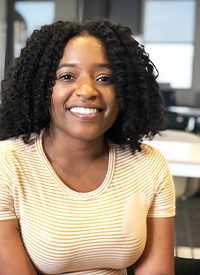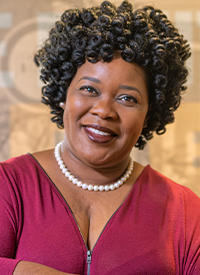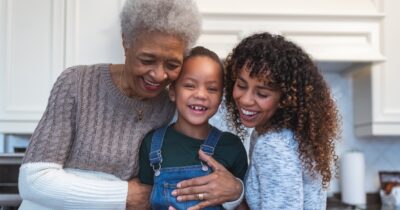A Conversation with Beatrice Beverly & Tashi CopELand

Tashi Copeland

Beatrice Beverly
Mental health has been a topic dominating the headlines throughout this pandemic. From stigma to access, this conversation with Tashi Copeland and Beatrice Beverly, board president of the National Alliance for Mental Illness (NAMI) of Greater Indianapolis and CICF community ambassador, on her perspective of mental health in our society.
TASHI – Tell me about the National Alliance of Mental Illness (NAMI). What’s its role in the community and what’s your role with the organization?
BEATRICE – NAMI was established by two Caucasian women who couldn’t find resources for their children who were diagnosed with a mental illness. They wanted to establish support groups for parents and mothers who had children that were diagnosed. And so, from there it just grew. There are several affiliates and arms to the national chapter. You have NAMI Indiana which is at the state level that focuses primarily on policy change and law. Then you have NAMI Greater Indianapolis that supports programs that are applicable for youth and their caregivers and families.
One year, I was asked to speak at their annual meeting in regard to our son, who was diagnosed. And after speaking,they asked me to consider a seat on the board of directors. When I did, I immediately had the thought, do we provide culturally intelligence programs and support to people of color? I knew the answer
Prior to my coming on board, NAMI’s targeted population—I’ll just say it—was White people. And they didn’t venture much outside that realm. When I was looking for help and support for my son, I didn’t even know what NAMI was. All I really had was folks telling me to pray. And I do pray because I believe in God. I believe in a higher calling. But that support piece was still missing for me and my family. And then there’s the stigma that’s in the African American community and the shame that comes with “what did I potentially do as his mother to cause this.” It was a lot of “stuff” hindering me and my ability to help my son.
I immediately had the thought, ‘do we provide services to people of color?’ I knew the answer.
As I attended the monthly board meeting, I’m thinking, “man, I would have loved to have something like this,” but then I thought, I don’t think this was designed with me/us in mind! Was my family history/dynamics, experiences with the medical institutions, trauma, stigma, etc., considered when this was designed? So, when I became president of NAMI Greater Indianapolis board, I said, oh, shouldn’t have done that.
Three years ago, we changed our strategy to include and target audiences that we have not been targeted before—communities of color. I want to be clear, we have not, nor will we discount the amazing work that has been done for the original population, but we needed to extend and throw a wider net so that all people could have the support and education based on what they needed.
It’s one thing to have support, but there’s another thing to be educated on how you navigate this illness. And how you’re able to articulate what you need in your community, family, and neighborhood. Hence specific programs and conversations created based on the voices of people that were not being touched.
In that same realm, can you kind of dive into the intersectionality between mental health care and one’s experience being a member of an under-appreciated community or community of color?
You know when you think about who you are as a Black woman… first of all, you feel like you didn’t have access to mental health care, right?
That’s pretty accurate.
So not only do you feel like you don’t have access, but you’re also working through your own stuff based on your upbringing. You’re working through, “no, you pray about it and it’ll be okay” or “that’s Uncle Joe that’s sitting in the corner, he’s always been like that, he’s alright.” Or “I don’t want to be known as crazy.” So, when you think about it, you begin to hold all that in so you never get to a place of feeling “okay.”
And so, when you talk about how do I ever get to a place where you have the appropriate level of mental health care, it must start with breaking the stigma, removing the myths through education so that we can demand that medical institutions gave us the proper care we deserve.
I believe that mental health care looks different for different people based on their experiences, based on their cultures, and based on what is acceptable for them. Take me for example. I had to unlearn so that I could relearn and not navigate from a place of fear, based on what I was so afraid of! Don’t get it twisted, because that lens comes from the things that have been done to us over centuries/decades and it has not been forgotten; but I had to set that aside if I was going to be able to advocate for my son and others. Keep in mind that me choosing to set it aside does not mean I have forgotten, but I have forgiven. The other thing is that all of these factors define how much trust I will extend to a person (especially if they don’t look like me), institution, therapist, etc.
Removing the stigma and understanding the difference between facts and myths and what my family and community needed brought me to the place of not only talking about it but being about the change that needed to happen. Imagining the possibilities sets the direction for change. It may not look like taking medicine. It may not look like talking to any therapist because they are on someone else’s picklist. What it may actually look like is neighbors and neighborhoods having conversations and supporting each other. It could look like art therapy, yoga and mindfulness therapy, martial arts. It looks like authentic, truthful untold stories from individuals that look like you and me. This is not your “traditional mental healthcare” and it is not one size fits all.
When we’re thinking about stigma, do you feel like there are certain things in our society that are still helping to perpetuate this historical stigma about seeking treatment for mental health?
Yes, I do believe that there are things still perpetuating “stigma” in our society but what I believe more is that we are taking our power back. We are defining and implementing what it is that we need so that we can thrive and continue to grow. We are helping institutions, doctors, therapists, etc., understand this as well. When this happens, it increases one’s confidence and understanding in the mental health space, which in turns removes the stigma.
The pandemic really exacerbated many societal issues and also highlighted disparities that have been in existence for quite some time. As the U.S. is starting to open up, and we’re doing better with COVID, how can we keep the conversation and need for action surrounding mental health support—specifically in underappreciated communities—when we’re moving away from the pandemic?
Implementing programs and resident programs that can run in neighborhoods creates sustainability over time. The residents become advocates for not only themselves but they become their neighbors, brother and sisters’ keepers. This type of empowerment, this type of mind-shift, is not a 9 to 5. It is a lifetime of support, no matter the day or time. This also sends a message to folks that we are no longer doing business as usual.
Instead, we have to say, ‘This is yours, we heard you. This is your program, ran in your neighborhood.’ If we don’t build a system within the body in which they live, work and play, we will be back to where we were—where the expectation is you need to come into a formal treatment program or you need to be medicated, right? This may still be needed but we have to consider and embrace what else is needed as well.
And that’s what we’ve done during COVID, we started Mental Wealth Hour. You may be sitting around with your girlfriends or your neighbors in your neighborhood. People just say, “hey guys, we’re going to meet here on Friday night—we’re going to build our mental wealth account during our Mental Wealth Hour.” There may be hotdogs, there may be drinks or music and dancing. It doesn’t have a standard set of rules or look. It looks like what’s right for them! It becomes a safe and brave space where folks start talking about mental health, their struggles. The residents are authentically supporting and building each other up because they trust each other—they are neighbors, they are their community. They are building their mental health account while removing the stigma and the myths that have plagued Black and brown communities for decades. We keep talking about generational wealth—let’s build that wealth as it pertains to mental health, hence the name “Mental Wealth Hour”.
Now that we’re coming out of the pandemic and everybody’s like oh, you know, everything’s getting “warm and fuzzy,” we can’t make mental health just a hashtag. It can’t have just been a trend during 2019. It has to be—and continue to be—a movement for the BIPOC population, and it’s going to take all of us to keep moving it. #USMOVEMENT






Leave A Comment